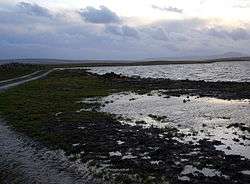Loch of Harray
| Loch of Harray | |
|---|---|
| Harray loch | |
 Looking southwards along the shoreline | |
| Location | Mainland Orkney, Scotland |
| Coordinates | 59°1′24″N 3°13′40″W / 59.02333°N 3.22778°WCoordinates: 59°1′24″N 3°13′40″W / 59.02333°N 3.22778°W[1] |
| Type | freshwater loch |
| Primary inflows | Burn of Hourston and Burn of Netherbrough[1] |
| Primary outflows | Loch of Stenness[2] |
| Catchment area | 45 sq mi (120 km2)[1] |
| Basin countries | Scotland |
| Max. length | 4.66 mi (7.50 km)[1] |
| Max. width | 1.75 mi (2.82 km)[1] |
| Surface area | 3.75 sq mi (9.7 km2)[1] |
| Average depth | 9 ft (2.7 m)[1] |
| Max. depth | 14 ft (4.3 m)[1] |
| Water volume | 951,000,000 cu ft (26,900,000 m3)[1] |
| Surface elevation | 3.6 ft (1.1 m)[1] |
| Islands | several islets and stones[1] |
The Loch of Harray is the largest loch of Mainland Orkney[1] and is named for the nearby parish of Harray. It lies immediately to the north of the Loch of Stenness and is close to the World Heritage neolithic sites of the Stones of Stenness and Ring of Brodgar.[3] In Old Norse its name was Heraðvatn.[4]
Hydrology
The loch was surveyed[1] on 21 August 1903 by Sir John Murray and later charted [5] as part of the Bathymetrical Survey of Fresh-Water Lochs of Scotland 1897-1909. Murray observed that Loch of Harray is a freshwater loch, the largest in all Orkney with an area of approximately 3.75 square miles (9.7 square kilometres) and volume of 951,000,000 cubic feet (0.0269 km3) and that it is somewhat influenced by the tides in the Hoy Sound although there is little variation in its level. The loch is connected to the Loch of Stenness at the Bridge of Brodgar.[6] The two lochs together cover an area of 19.3 square kilometres (7.5 square miles) making the two combined the ninth largest loch in Scotland by area (as listed by Murray and Pullar (1910)). Murray recorded that despite there being an inlet allowing the free flow of water from the Loch of Stenness it has little impact on the marine biology of Harray and no seaweed was present, the water tasted fresh and normal freshwater plankton were seen. [7]
Natural history
The loch is a Site of Special Scientific Interest and has a large number of pondweed species three of which are scarce, a rare caddis fly (Ylodes reuteri) and is the only known site in Scotland for a nerite snail Theodoxus fluviatilis which is more commonly found in English rivers. A wide variety of wildfowl winter at the loch including pochard, tufted duck, scaup and goldeneye.[8][9]
References
- 1 2 3 4 5 6 7 8 9 10 11 12 13 "Bathymetrical Survey of the Fresh-Water Lochs of Scotland, 1897-1909, Lochs of Orkney". National Library of Scotland. Retrieved 2013-07-29.
- ↑ "Sites of Special Scientific Interest-SSSI, Orkney, Loch of Harray". Orkney Island Council. Retrieved 2013-07-29.
- ↑ "World Heritage List - Heart of Neolithic Orkney". World Heritage Convention, UNESCO. Retrieved 2013-08-04.
- ↑ Pedersen, Roy (January 1992) Orkneyjar ok Katanes (map, Inverness, Nevis Print)
- ↑ "View, Lochs of Stenness, Harray and Bosquoy - Bathymetrical Survey, 1897-1909 - National Library of Scotland". National Library of Scotland. Retrieved 2013-07-29.
- ↑ "Lochs of Harray and Stenness Site of Special Scientific Interest" Midas 1083. SNH
- ↑ Murray, John; Pullar, Laurence (1910). Bathymetrical Survey of Fresh-Water Lochs of Scotland during the years 1897 to 1909: report on scientific results. Edinburgh.
- ↑ "Sites of Special Scientific Interest-SSSI, Orkney, Loch of Harray". Orkney Island Council. 2013-07-29. Retrieved 2013-07-29.
- ↑ "Site Details for Lochs of Harray and Stenness". gateway.snh.gov.uk. 2013-07-29. Retrieved 2013-07-29.